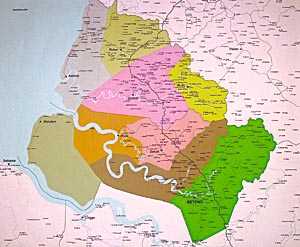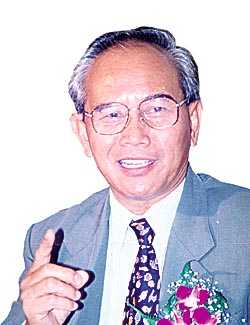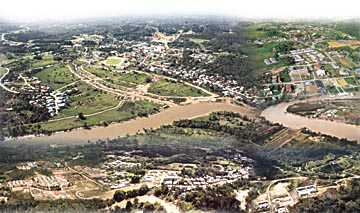

Setting the pace for transformation
With expanded infrastructure and the creation of new centres for the generation and interaction of new economic forces in the Upper and Lower Saribas basins, Betong Division can look forward to a prospective future. But a definitive change of mindset must precede all these, writes TOMAN MAMORA following an exclusive interview with Deputy Chief Minister Tan Sri Datuk Amar Alfred Jabu.

IT'S as if history has come full circle. For a moment, one can't help but sense that the spirit and energies of a legendary past have been invoked and juxtaposed with a rejuvenated Betong which celebrates its elevation to an Administrative Division today. Betong Division, or generally referred to as the Saribas basin, was the seat of the Iban civilisation and heartland of the early sea-faring Malay adventurers and has produced many 'firsts' in politics, business, education and culture.
The energies and legends of old are likely to resurrect to find new meaning and expression in the new economy, as Betong and the rest of the Saribas basin break loose from the rural trappings and forge ahead with a sense of great promise to an era of greater development and progress.
"The creation of the new Division will provide definitive focus on administration and enable the Government to concentrate on development and transformation of the people in the rural areas," says Betong-born Deputy Chief Minister Tan Sri Datuk Amar Alfred Jabu.
However, he is quick to point out: "Compared to urban areas, most parts of the Betong Division have not enjoyed as much development but given time and with the planning of major socio-economic projects, the new Division will shed its rural image and assume a rightful place in the mainstream of modernisation."
The creation of an administrative division for Betong is justified in view of its sufficiently large population base and its representation in Parliament by two Members of Parliament - basic prerequisites which had earlier defined the creation of the Mukah Division.
Stresses Jabu: "I have never lobbied for Betong to be a Division. Rather, it is a manifestation of the Government's recognition of the commitment of the people of Betong to continued development, peace and harmony. They have been supportive of the government and its development policies in the past 28 years."
Betong Division is made up of two existing districts, namely, Betong and Saratok, and parts of Meludam, Skrang - giving a total area of 4,000 sq km with a population of more than 100,000 people. Saratok district spreads over 1,687 sq km and has a population of 37,939 while Betong district has 69,114 people with a territorial jurisdiction of 1,776 sq km. Plans are also in the offing for the upgrading of the existing sub-districts of Kabong and Pusa to districts.
Betong Division has a culturally mixed population, with Ibans, Malays and Chinese interacting well in almost all spheres of activity since the pre-colonial days. Jabu describes such a well-knit and harmonious social fabric as a priceless asset that is certain to propel Betong Division to break new frontiers of development and harness its vast rural potential.
Infrastructure germane to development
As in any rural areas, Betong has its share of challenges. While the Ibans, who dwell in the upper Saribas basin, are looking forward to their NCR land to unlock the proverbial gate to their future economic livelihood, the Malays in Lower Saribas are optimistic of the creation of linkages early so that they can harness their arable land and harvest the sea.
"The coastal belt of the Lower Saribas basin has yet to enjoy the benefit of the coastal road which will only be completed in 3 to 4 years. The coastal road, currently under construction, will eventually link Meludam, Teriso, Beladin, Pusa, Kabong, Gerigat and Selalang with extended link to the main trunk road in the interior," says Jabu, stressing that the completion of the coastal road will provide impetus for the creation of new economic forces and linkages for their interaction and convergence.
Jabu, who is also Minister of Land and Rural Development, reiterates that germane to the development of Betong Division, like Mukah Division, is the provision of an extensive network of infrastructure and utilities.
"Otherwise, the newly created Administrative Division may face the serious problem of a widening development and information gap," he emphasises.
Physical development alone is not enough to change the socio-economic landscape and bring about transformation in the rural areas, the people must change their mindset and be prepared to catch up with the rapid development in education so that they will be able to make good the vast opportunities under the Third National Outline Perspective Plan, he adds.
Construction work will soon start on the installation of an extensive system of main pipes supplying treated water from Ulu Layar to end-users in the coastal area which is known to have suffered perennial shortage of water during the drought season. Jabu is optimistic, barring unforeseen circumstances, that the water supply network will be completed within the next five years.
Infrastructure development and the provision of utilities will augur well for the rapid growth of Rural Growth Centres (RGCs) at Beladin and Ulu Layar, which will serve as catalysts in activating the growth of smaller towns such as Debak, Gerigat, Nanga Budu, Kabong and other outlying areas within the Division.
Prospective future for coastal belt
Jabu speaks of the prospective future of the coastal belt of Betong Division, following successful re-search and introduction of the latest technology in peat soil development. "In the coastal belt, vast areas of reasonably shallow peat soil can be drained and used for commercial agriculture capable of giving crop yield much higher than in the interior," he remarks with optimism.
In the interior, the problem of accessibility, which hitherto has affected development of the NCR land, has been duly overcome with the construction of roads linking towns with longhouses and sub-centres. Says Jabu of the changes that infrastructure has brought to the longhouse folk: "Compared to 25 years ago, a lot of changes, which were previously undreamed, have taken place in the rural areas and the longhouse folk no longer have to spend half a day or a full day to get to the nearest towns like Saratok or Betong to conduct their routine business activities as they now enjoy good roads and other good communication facilities.
"In Saratok and Betong districts, I dare say no area is out of reach within 7 to 8 hours, and we hope to reduce the travel time to no more than 3 hours soon. We will realise this by 2005," Jabu points out.
But central to the long-term development of what is predominantly a rural Division is expansion of education and the development of a well-trained and knowledgeable workforce. Jabu acknowledges this and is proud that so far, the results of SPM examination for most secondary schools in the Betong Division have been satisfactory in the past 5 years and show signs of continued improvement.
Betong students potential rural force
"The results of SPM of secondary schools in the Betong Division in the last five years revealed a passing rate that was higher than the national average. In 2001, the SMP passes of secondary schools in the Division were 70.2 per cent, well above the State average of 68.4 per cent and national average of 69.6 per cent," he says emphatically, adding that although these schools are in the rural areas, the students have proven that they have the brain power.
To Jabu, they represent a potential force from the rural areas in the next 5 to 10 years and is convinced that there is enough motivation and drive in the rural area to push the students to do well academically.
The picture looks promising for the rural students in the Division with the soon-to-be completed MARA Junior Science College and establishment of two community colleges at Debak and Saratok under the Eighth Malaysia Plan.
"The Government will continue to expand educational opportunities in the Division through the schools development programmes and thesetting up of skill development centres. Under the Eighth Malaysia Plan, new primary and secondary schools are to be built and several existing schools to be upgraded," Jabu says of the plan to enhance education in the Division.
With its large tracts of arable land and fast expanding infrastructure
network, Betong is poised for further development in plantation industry
and rural-based small and medium scall industries, and opportunities are
abundant for private sector investors to set up joint ventures. Stresses
Jabu:
"There are great prospects in modern plantation agriculture,
fisheries, and SMIs. In particular, there is much scope for plantation
development as there are large holdings of land banks under the native
Customary Rights (NCR) land development concept."
He adds: "I look forward to the influx of increased investment into the Betong Division, with capital and other resources being brought in to develop oil palm plantations in both the upper and lower Saribas basins as well as to set up private institutions of higher learning."
Investment in plantation industry
"I foresee there will be a lot of interest in terms of investment in Betong in much the same manner in Samarahan and Mukah.. For a place to grow, there must be an injection of capital which does not necessarily come from the Government alone. The Government is the provider of development catalysts in the form of infrastructure, schools, utilities, clinics, and RGCs. But the engine of growth is very much the private sector," Jabu says of the role of the private sector in the development of Betong.
To date SALCRA has developed a total of 4,300 hectares of oil palm plantations in the Division, primarily in Saratok, part of Betong and Upper Saribas, and plans are in the offing under the 8MP to consolidate 6,000 hectares of scattered plantations into one contiguous block which will make management ore cost-efficient and effective.
To date, the Saratok-Roban belt produces about 24,000 tons of fresh fruit bunch per hectare per year whereas the commercial average is around 15,000 tons per hectare. This high production is attributed to the well-drained shallow peat soil in the area, says Jabu who is confident the tonnage will continue to increase with expanded acreage.
FELCRA is also currently involved in developing NCR land for commercial agriculture in Spaoh-Debak area, and with research on local peat soil being carried out in Sessang, optimism is high on higher yield of oil palm yield from the Saribas basin.
Soon, settlers in the now defunct rubber schemes in Skrang and Melugu will get a new lease of life following the Government's decision to plant the areas with oil palm.
Being centrally positioned, Betong presents itself as an ideal choice for the administrative capital for the Division. But development of Betong will ultimately depend on the development of the satellite towns and the vast hinterland, quips Jabu. Hence, it is important that Betong is properly linked to all these places to enhance mobility of people, goods and services and facilitate interaction of the local economic forces.
New administrative complex
About 300-500 government officers of all levels and categories will soon be posted to Betong, and this marked increase in number from the present size of 100 officers will necessitate the setting up of a new administrative complex and government quarters.
A new administrative complex, comprising the Residency and administrative offices will be built on a hill and ridges overlooking the town of Betong and are expected to be ready in 24 months' time.
In addition, 200 units of government quarters to cater to the housing needs of State and Federal officers will be constructed at the foothill adjacent to the administrative complex and will be ready during the same period.
"The new Residency is being planned on a hill surrounded by three ridges overlooking the town of Betong. Three blocks of offices will be built on the ridges. The site of the new Government complex is both strategic and symbolic, with the propeller-like shape of the hill and ridges denoting that Betong is being propelled to new heights of development and progress," says Jabu who alludes comfortably to the geomancy of the site.
To many, the development of Betong and the greater part of the Saribas basin is synonymous with Jabu's stewardship. The suggestion, albeit hyperbolic to some well-meaning critics, is understandable and deserves some stock-taking.
Most of the major development projects implemented in Betong over the last two decades and which have transformed it into a productive and economically progressive area were initiated by Jabu.
With a population in excess of 30,000, Betong is rapidly transforming into a major rural development centre - well planned and developed. It has all the basic amenities including modern communications network, roads, hospitals, electricity and treated water supplies, schools, modern government administrative offices, police station and fire station, sporting facilities, as well as a handicraft centre.
- The success of Betong has been made possible with the active
participation of the people in the government's mainstream programmes on
sustainable land development and utilisation.
